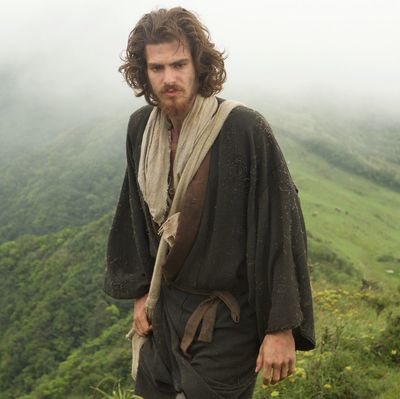
This post discusses the ending of Silence in detail.
The priest tasked with making sure Silence got its Jesuit details right has seen The Wolf of Wall Street, and he chuckles when I bring it up. I’m sitting in Reverend James Martin’s office, in the same place where he spent about a year teaching Andrew Garfield about Jesuit prayer. Martin, the editor-at-large of the Jesuit magazine America, is devout, energetic, and open, so I’m curious to know how it felt — even as a Scorsese fan — to reckon with a director whose previous feature was full of frenetic bacchanalia. Was it weird? “Marty’s been working on this movie for as long as I’ve been a Jesuit,” the priest, who worked as the movie’s theological consultant, says. “But I was talking to Marty’s research assistant after they’d just finished working on Wolf of Wall Street, and she said ‘This is a lot more enjoyable.’ That movie is all about cocaine use!”
Silence tells the story of two Jesuit priests who travel to rural Japan to recover their wayward mentor. Though it’s The Wolf of Wall Street’s spiritual opposite, the two movies are equally intense — neither the religious epic or the vice-fueled free-for-all ever let up. Like Wolf, Silence exists on one note, all-or-nothing. The “all” here is a life spent with Christ; the “nothing” is the temptation to publicly renounce the faith.
That’s what happens in the two hours of the torture of the two priests and the Japanese Christians. Silence moves in circles of interrogation and near-defeat: Over and over again, Father Rodrigues (Andrew Garfield) stands on the sidelines as the Christians he ministers to are tortured. Give up Christ, his capturers say, and their suffering will stop. Denouncing the faith comes in the form of a particularly visual framework: The Buddhist shogunate presents each Christian with a fumi-e, a small square image of Christ, asking them to step on it. “It’s only a formality,” a samurai says sometimes, prodding the believer in a devilish whisper.
Silence is about faith, but it’s also an interrogation of colonialism, a movie that sees two white actors spend every scene preaching to or being interrogated by a cast of Asian actors. Martin defends missionary work as pure-hearted, but allows that the history of spreading the gospel isn’t perfect. The plot, which comes straight from Shūsaku Endō’s 1966 novel, is clearly critical: The two young priests are stubborn from the start, and the Japanese men call them out on their pride. “He’s arrogant, like all of them,” a Japanese interpreter says once Rodrigues is out of earshot. “But he’ll fall.”
It would be easier if apostasy were do-or-die, Martin explains; martyrdom would be a tidy conclusion. The Midtown priest suggested a line from the church’s early days to Scorsese and screenwriter Jay Cocks, and it ended up in the final cut: “The blood of martyrs is the seed of the church.” Both the novel and the movie ask a more complicated question of faith. “In the film, Rodrigues has to decide whether or not to apostatize and give up the faith — at the risk of giving up everything he knows and loves — or not apostatize and risk the lives of the Japanese Christians,” Martin says. “That’s why it takes him so long to do it, because the most important thing in his life is his relationship with Jesus.”
To a modern audience it seems simple enough: Step on Jesus now, repent right after. But it’s a paradox that almost drives Rodrigues insane. He’s captured by the Japanese inquisitor and thrown in a jail cell, but the harsh dogma of his faith becomes his cage. There’s no scripture or prayer for this kind of moral question, nothing in his theology to guide him through his suffering. In prayer, God is silent until the climax, when Rodrigues hears the Lord’s voice. “Step on me,” Christ instructs. And so Rodrigues does. “There’s a tradition in Jesuit spirituality called the third degree of humility,” Martin says. “It’s when you do something that will seem ridiculous to everyone but it’s the right thing to do. The comparison is to Jesus accepting his crucifixion, even though all of his disciples were horrified. Rodrigues’s apostasy makes no sense to the world, but God is asking him to do it.”
Conservative Catholics have questioned the movie’s theology, and a long-debated question about the novel has resurfaced. Is it even God’s voice that Rodrigues hears, or is this relief conjured from the priest’s desperation? The novel doesn’t take a side — “it’s maddeningly vague,” Martin says — but Scorsese’s movie gives a cleaner conclusion: Rodrigues spends the rest of his days in Japan apostatizing until the final frame, when he’s buried as a Buddhist with a hidden cross. “I find the ending absolutely shattering,” the priest says. “I cried when I read it, and then I cried again when I saw it.” He’s seen it three times: once at Scorsese’s office, and at a pair of screenings in Rome. Martin organized a special screening for Jesuits in Rome, and gave Scorsese and some of his creative team a tour of Jesuit holy sites in Rome.
What seems like cognitive dissonance gets back to the movie’s clearest theme. The reason Scorsese pushes aside the structure of organized religion and criticizes the colonialist imperative to spread a Western Gospel is because Silence is obsessed with dismantling certainty: There’s no way to know what’s in another’s heart, or to fully know someone else’s relationship to God.
“The movie is hard for religious people because it subverts some of the genres,” Martin explains. “And it’s hard for non-religious people because it demands that you see everyone’s faith with complexity. This isn’t the fake spirituality of ‘If you believe in God, everything turns out great.’ This movie says you can believe in God but bad things might still happen. And then it asks, what do you do with that faith?”


